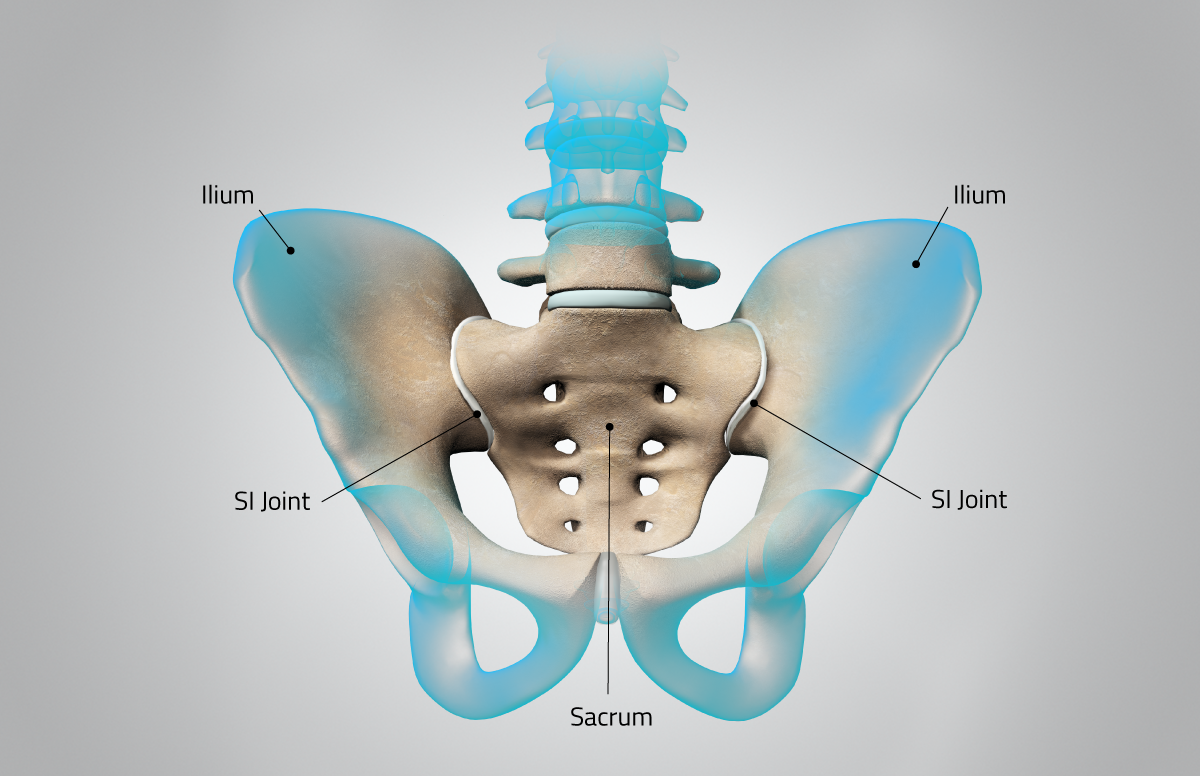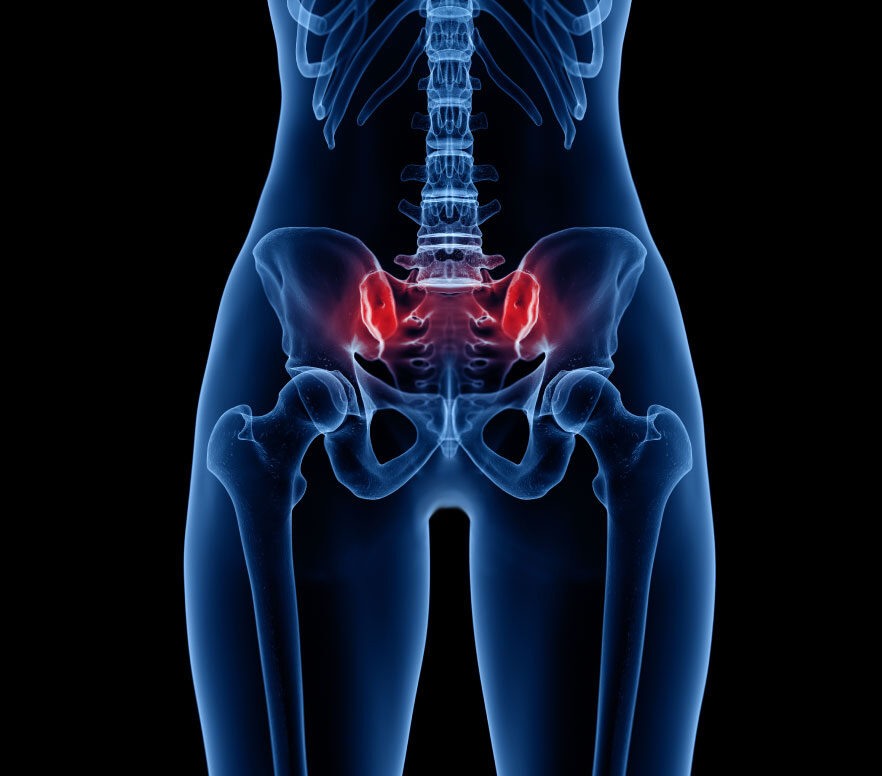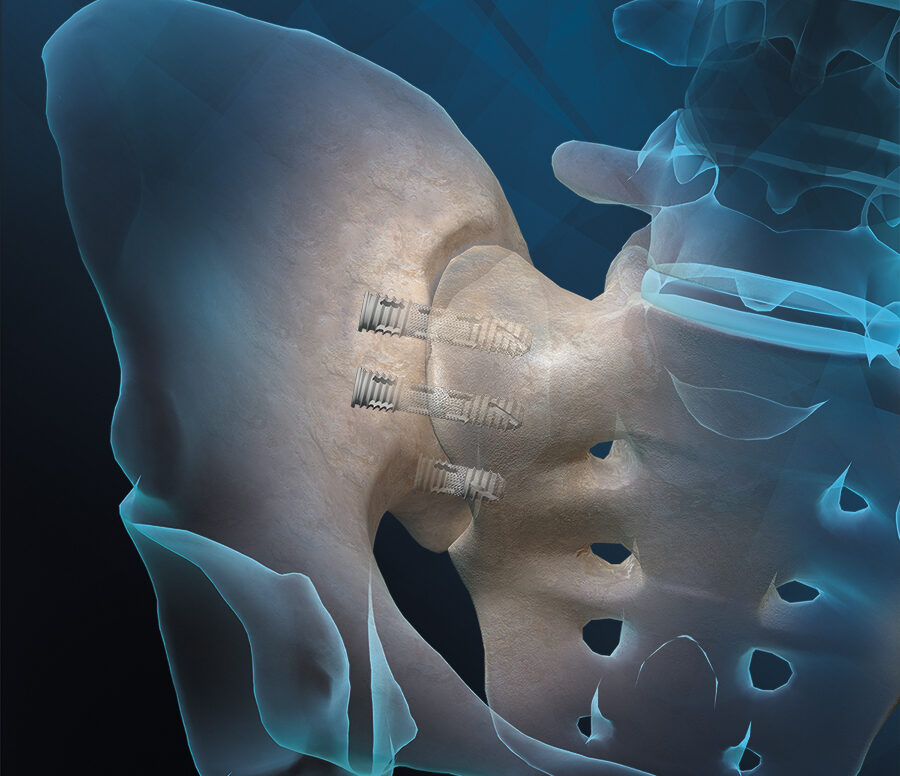
Hip and Low Back Pain
Understanding SI joint pain
Do You Experience Lower Back Discomfort or Numbing Pain in Your Legs?
You may be experiencing hip and low back pain, or more specifically, sacroiliac (SI) joint pain, which can cause debilitating back and leg problems. SI joint pain occurs in an estimated 15-30 percent of people with lower back pain.1 SI joint dysfunction is also the leading cause of lower back pain for women over 35 years old who have been pregnant or recently given birth.2 However, the complex nature of the SI joint makes identifying and treating SI joint pain difficult. While many individuals suffer from sacroiliac pain due to an injury, many more patients may not be able to pinpoint what is causing their discomfort.

What is the Sacroiliac Joint or SI Joint?
The SI joint is where the spine and the pelvis meet. It’s the joint between the sacrum and iliac crests of the pelvis, which are connected by muscles, tendons and ligaments. The sacrum is the triangular bone between the lumbar spine and the coccyx, otherwise known as the tailbone. The sacrum supports the spine and is supported by an ilium on each side. The SI joint ligaments allow little movement and provide stability. The human body has two SI joints, one on each side of the body. Both SI joints support the entire weight of the upper body and function as shock absorbers for the spine during walking, running, jumping and bending to reduce pressure on the spine.
What Causes SI Joint Pain and Dysfunction?
Sacroiliac joint dysfunction typically comes as a result of moving too much or too little, such as prolonged sitting. Any change in the SI joint’s normal function and motion may trigger sacroiliac pain. During certain movements of the spine or hips, beyond what the SI joint can withstand, inflammation and injury may occur. When the joint becomes inflamed it causes pain. This inflammation, or sacroiliitis, can sometimes cause pain in the lower back, buttock or thigh, and/or leg, depending on the amount of inflammation.
Certain factors can raise the risk of developing SI dysfunction and pain, including:
- Injuries to the joint as the result of a trauma such as a fall
- Prior lower back surgery
- Leg length discrepancies
- Gout
- Osteoarthritis
- Inflammatory arthritis
- Scoliosis
- Advanced age
- Pregnancy and childbirth
Being pregnant puts additional stress on the SI joint, so women who are pregnant or have recently given birth may be more susceptible to sacroiliac joint pain. Pregnancy or recent childbirth can cause SI joint pain in women due to weight gain, hormonal changes causing ligaments in the SI joint to relax, and pelvic changes and instability associated with childbirth. In addition, as we age the characteristics of the sacroiliac joint change.
See your medical provider to determine if your pain is a symptom of an underlying condition or a simple strain of the SI joint.

Signs and Symptoms Associated
with an SI Joint Problem

Aggravation of the sacroiliac joint can commonly result in inflammation. This condition may be the primary cause of pain, stiffness, and other symptoms. The symptoms of SI joint pain may vary from person to person and are similar to and are often confused with symptoms of other issues or injury.
- Pain can develop spontaneously or after a traumatic event. Pain can also increase with activity or repetitive bending and twisting motions.
- Pain in the lower back, hips, groin or buttocks can range from mild to severe. Pain is typically felt only on one side but may be felt on both sides.
- SI joint symptoms can include:
- Pain that radiates from the pelvis to the legs or feet.
- Pain, numbness, tingling or weakness in the legs.
- Pain that worsens when standing up from a seated position or while climbing stairs.
- Stiffness, often unilateral, that increases with prolonged sitting or prolonged walking.
- Instability in the pelvis or lower back that may feel like it will buckle when standing, walking, or moving from standing to sitting.
- Disturbed sleep and sitting patterns.
Visit a specialist or provider to learn more and determine if you are at risk.
How is SI Joint Dysfunction Diagnosed?
SI joint pain is often overlooked because of the difficulty in diagnosis. Diagnosis is challenging because imaging may not reveal the damage and symptoms can mimic other common conditions such as sciatica, a lumbar herniated disc and hip arthritis. Your orthopedic surgeon will note your medical history and conduct a physical examination using specific tests to reveal the source of your pain.
Commonly used diagnosis techniques include:
- Assessment of patient history, including prior trauma and treatments, and current conditions
- Provocative tests
- Diagnostic imaging
- Diagnostic SI joint injections

What are Treatment Options for SI Joint Pain?
Preventing SI joint pain starts with understanding what aggravates your SI joint. There are nonsurgical and surgical options to address SI joint pain.
Some common treatment recommendations for SI joint pain include nonsurgical treatment options like low-impact aerobic exercise, physical therapy, yoga, massage, ice packs alternated with heat, back braces, and muscle relaxers and anti-inflammatory over-the-counter medications. If your pain does not respond, your doctor may order oral steroids to reduce SI joint inflammation, steroid injections and ablation to deactivate the nerves that cause your pain.
If your pain does not respond to these treatments, surgery may be recommended. There are minimally invasive surgical techniques. The standard surgery used to address SI joint pain is sacroiliac joint fusion. The goal of this procedure is to eliminate movement at the sacroiliac joint.
Deciding on Sacroiliac Joint Surgery
SI joint fusion can be accomplished in a “traditional” or “open” SI joint surgery or with minimally invasive surgery. However, minimally invasive procedures can improve outcomes in pain and reduce recovery time. Sacroiliac fusion involves the use of implanted screws, as well as a possible bone graft across the joint.

The FIREBIRD SI Fusion System
The FIREBIRD™ SI Fusion System is the first 3D-printed titanium SI screw with nanotechnology specifically designed to compress and stabilize the SI joint for patients being treated for pain and dysfunction of the SI joint.
The FIREBIRD SI Fusion System is implanted through a minimally invasive procedure that involves inserting two to four bone screws across the SI joint to stabilize the joint during the fusion process. The system’s 3D-printed mid-shaft porous region is designed to allow for bone growth through the device to aid in the fusion process.

What Can I Expect After Surgery?
The desired outcome of your sacroiliac fusion procedure is a completed fusion where pain caused by sacroiliac joint dysfunction is decreased. Progress varies in time from patient to patient and is also dependent upon mitigating factors ranging from your health to environment. Your progress will be monitored by your surgeon through follow-up visits.
- Cohen SP, Chen Y, Neufeld NJ. Sacroiliac joint pain: a comprehensive review of epidemiology, diagnosis and treatment. Expert Rev Neurother. 2013 Jan; 13(1):99-116.
- McGrath C. Clinical considerations of sacroiliac joint anatomy: a review of function, motion and pain. Journal Osteopathic Medicine 2004; 7(1):16-24
Patients
Improving Patient Mobility Through Innovation
Our Mission is to deliver innovative, quality-driven solutions while partnering with health care professionals to improve patient mobility. We are proud to be part of the reason patients like Q’Shaun are able to get back to living their best lives.
